lock RENAULT TWINGO RS 2009 2.G Electrical Equipment - Access Safety User Guide
[x] Cancel search | Manufacturer: RENAULT, Model Year: 2009, Model line: TWINGO RS, Model: RENAULT TWINGO RS 2009 2.GPages: 43, PDF Size: 0.2 MB
Page 16 of 43
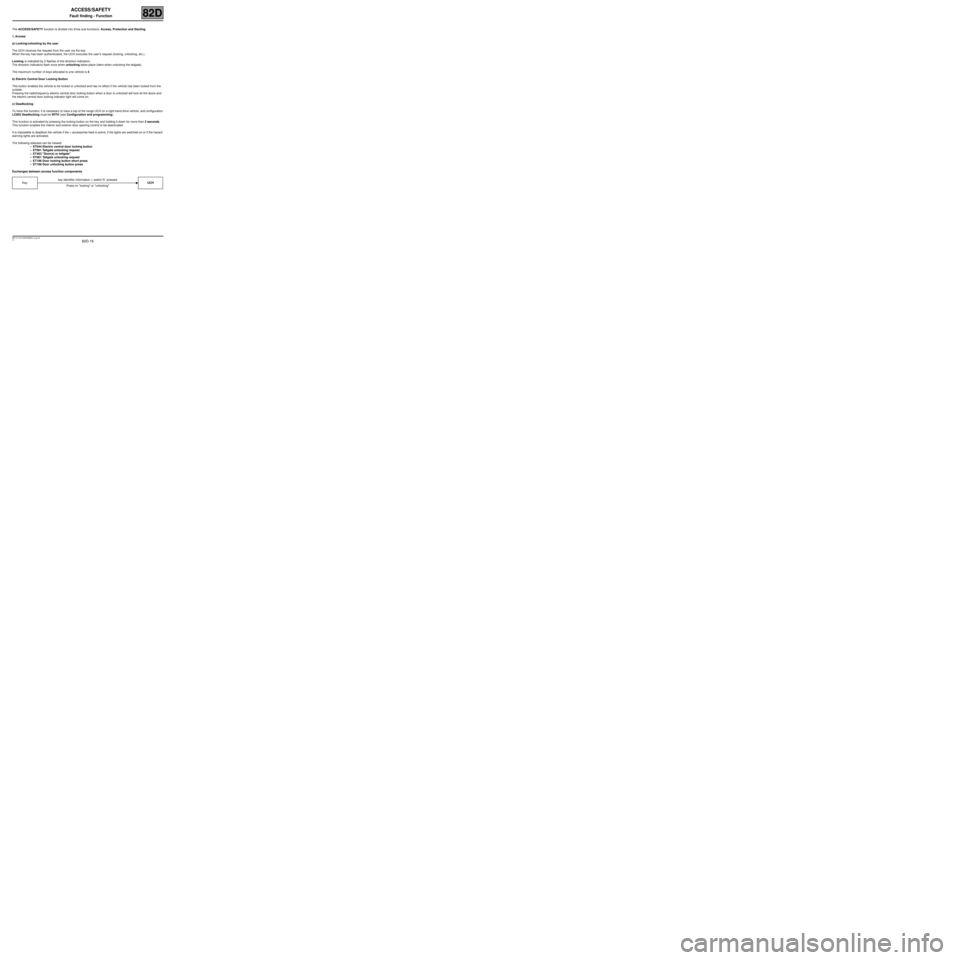
82D-16
MR-413-X44-82D000$500_eng.mif
V1
ACCESS/SAFETY
Fault finding - Function82D
The ACCESS/SAFETY function is divided into three sub-functions: Access, Protection and Starting.
1. Access
a) Locking/unlocking by the user
The UCH receives the request from the user via the key.
When the key has been authenticated, the UCH executes the user's request (locking, unlocking, etc.).
Locking is indicated by 2 flashes of the direction indicators.
The direction indicators flash once when unlocking takes place (idem when unlocking the tailgate).
The maximum number of keys allocated to one vehicle is 4.
b) Electric Central Door Locking Button
This button enables the vehicle to be locked or unlocked and has no effect if the vehicle has been locked from the
outside.
Pressing the radiofrequency electric central door locking button when a door is unlocked will lock all the doors and
the electric central door locking indicator light will come on.
c) Deadlocking
To have this function, it is necessary to have a top of the range UCH on a right-hand drive vehicle, and configuration
LC003 Deadlocking must be WITH (see Configuration and programming).
This function is activated by pressing the locking button on the key and holding it down for more than 2 seconds.
This function enables the interior and exterior door opening control to be deactivated.
It is impossible to deadlock the vehicle if the + accessories feed is active, if the lights are switched on or if the hazard
warning lights are activated.
The following statuses can be viewed:
–ET044 Electric central door locking button
–ET061 Tailgate unlocking request
–ET463 "Door(s) or tailgate"
–ET061 Tailgate unlocking request
–ET186 Door locking button short press
–ET189 Door unlocking button press
Exchanges between access function components
Keykey identifier information + switch N˚ pressed
UCH
Press on "locking" or "unlocking"
Page 17 of 43
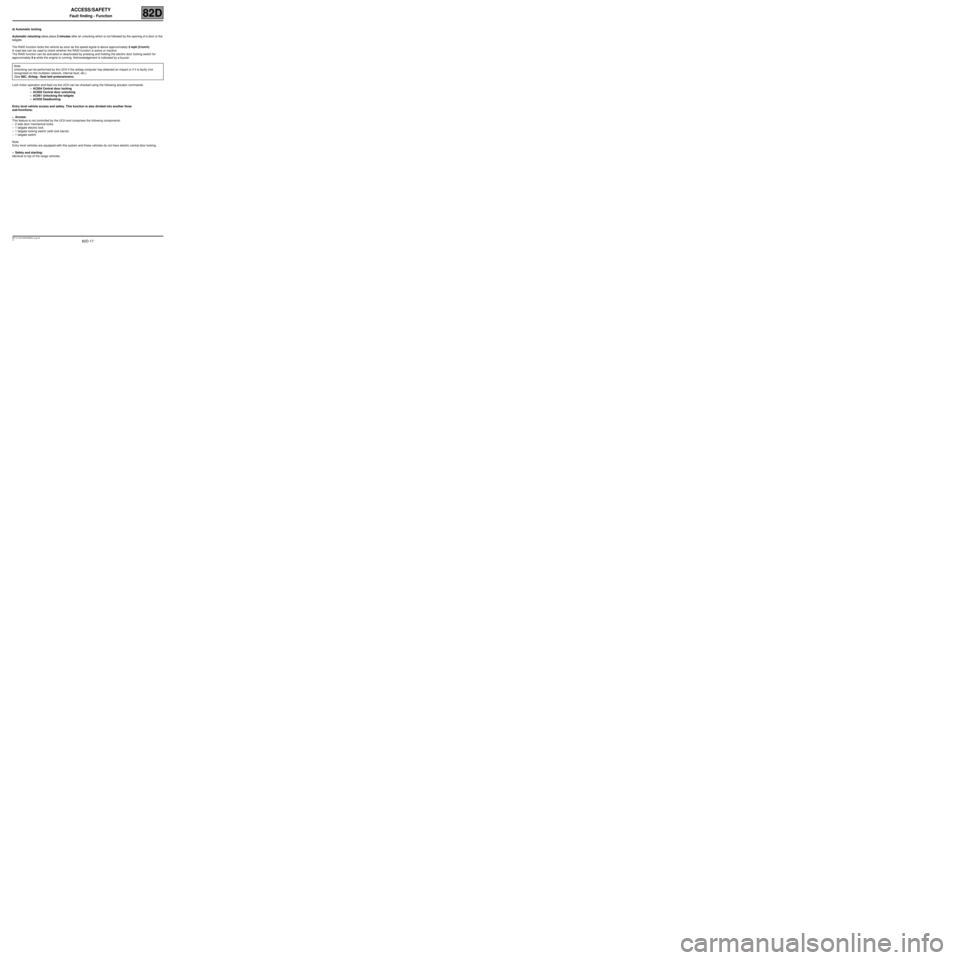
82D-17
MR-413-X44-82D000$500_eng.mif
V1
ACCESS/SAFETY
Fault finding - Function82D
d) Automatic locking
Automatic relocking takes place 2 minutes after an unlocking which is not followed by the opening of a door or the
tailgate.
The RAID function locks the vehicle as soon as the speed signal is above approximately 3 mph (5 km/h).
A road test can be used to check whether the RAID function is active or inactive.
The RAID function can be activated or deactivated by pressing and holding the electric door locking switch for
approximately 5 s while the engine is running. Acknowledgement is indicated by a buzzer.
Lock motor operation and feed via the UCH can be checked using the following actuator commands:
–AC004 Central door locking
–AC005 Central door unlocking
–AC061 Unlocking the tailgate
–AC035 Deadlocking
Entry level vehicle access and safety. This function is also divided into another three
sub-functions:
–Access:
This feature is not controlled by the UCH and comprises the following components:
–2 side door mechanical locks.
–1 tailgate electric lock.
–1 tailgate locking switch (with lock barrel).
–1 tailgate switch
Note:
Entry level vehicles are equipped with this system and these vehicles do not have electric central door locking.
–Safety and starting:
Identical to top of the range vehicles.Note:
Unlocking can be performed by the UCH if the airbag computer has detected an impact or if it is faulty (not
recognised on the multiplex network, internal fault, etc.).
(See 88C, Airbag - Seat belt pretensioners).
Page 18 of 43
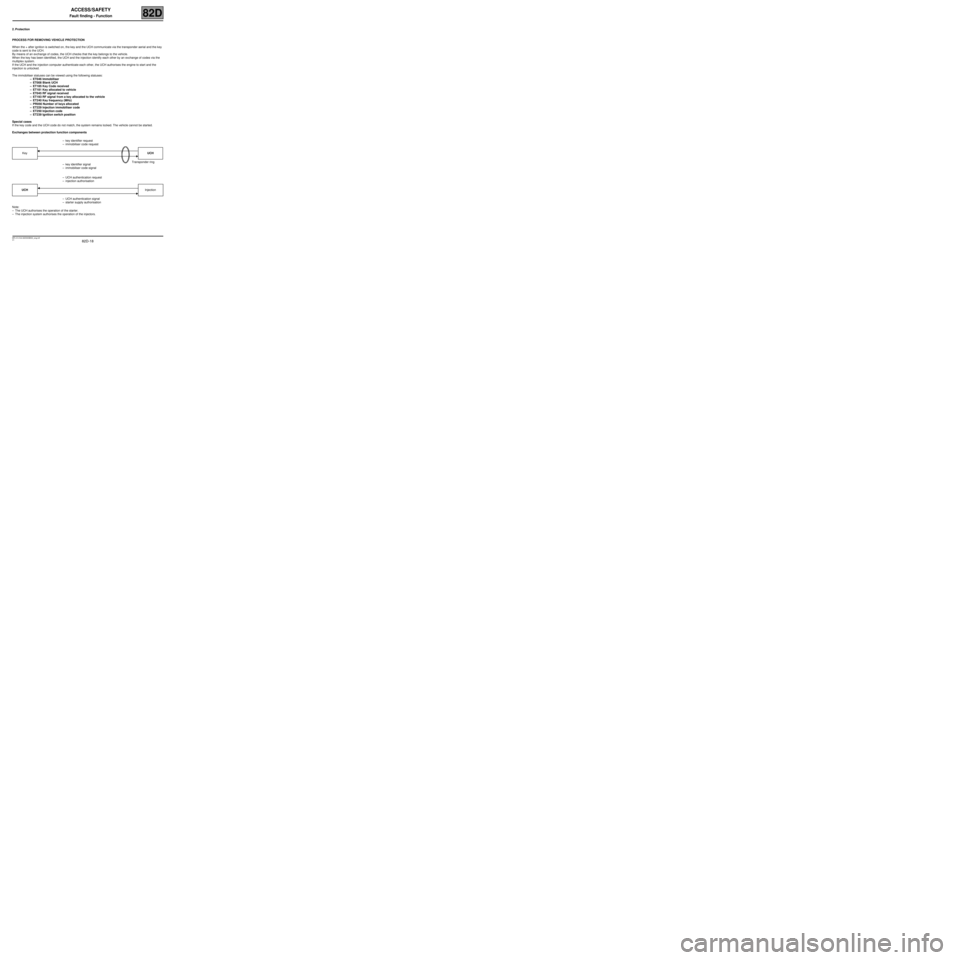
82D-18
MR-413-X44-82D000$500_eng.mif
V1
ACCESS/SAFETY
Fault finding - Function82D
2. Protection
PROCESS FOR REMOVING VEHICLE PROTECTION
When the + after ignition is switched on, the key and the UCH communicate via the transponder aerial and the key
code is sent to the UCH.
By means of an exchange of codes, the UCH checks that the key belongs to the vehicle.
When the key has been identified, the UCH and the injection identify each other by an exchange of codes via the
multiplex system.
If the UCH and the injection computer authenticate each other, the UCH authorises the engine to start and the
injection is unlocked.
The immobiliser statuses can be viewed using the following statuses:
–ET046 Immobiliser
–ET008 Blank UCH
–ET185 Key Code received
–ET181 Key allocated to vehicle
–ET045 RF signal received
–ET193 RF signal from a key allocated to the vehicle
–ET240 Key frequency (MHz)
–PR056 Number of keys allocated
–ET229 Injection immobiliser code
–ET250 Injection code
–ET239 Ignition switch position
Special cases
If the key code and the UCH code do not match, the system remains locked. The vehicle cannot be started.
Exchanges between protection function components
Note:
–The UCH authorises the operation of the starter.
–The injection system authorises the operation of the injectors.–key identifier request
–immobiliser code request
KeyUCH
Transponder ring
–key identifier signal
–immobiliser code signal
–UCH authentication request
–injection authorisation
UCHInjection
–UCH authentication signal
–starter supply authorisation
Page 19 of 43
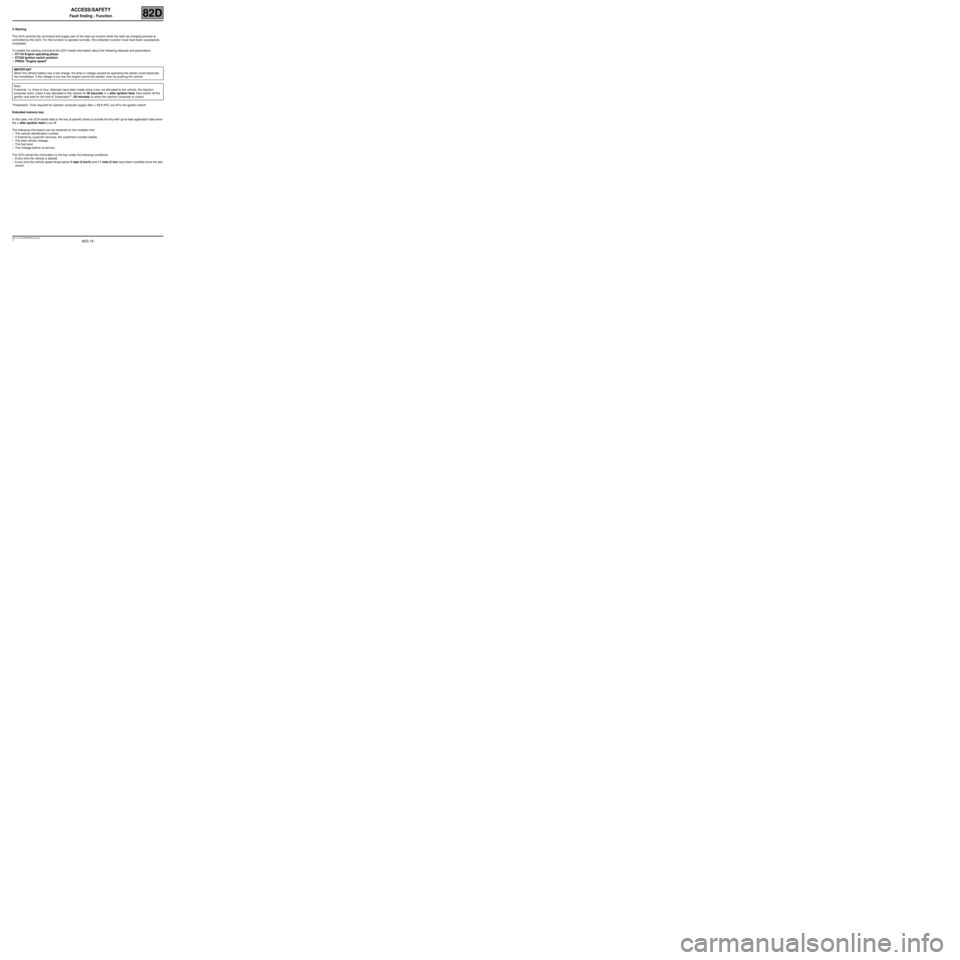
82D-19
MR-413-X44-82D000$500_eng.mif
V1
ACCESS/SAFETY
Fault finding - Function82D
3. Starting
The UCH controls the command and supply part of the start-up function while the start-up-charging process is
controlled by the UCH. For this function to operate normally, the protection function must have been successfully
completed.
To enable the starting command the UCH needs information about the following statuses and parameters:
–ET142 Engine operating phase
–ET239 Ignition switch position
–PR025 "Engine speed"
*Powerlatch: Time required for injection computer supply after + 12 V APC cut-off to the ignition switch.
Extended memory key:
In this case, the UCH sends data to the key at specific times to provide the key with up-to-date application data when
the + after ignition feed is cut off.
The following information can be retrieved on the multiplex line:
–The vehicle identification number.
–If entered by customer services: the customer's contact details.
–The total vehicle mileage.
–The fuel level.
–The mileage before oil service.
The UCH sends this information to the key under the following conditions:
–Every time the vehicle is started.
–Every time the vehicle speed drops below 3 mph (5 km/h) and if 1 mile (2 km) have been travelled since the last
record. IMPORTANT
When the vehicle battery has a low charge, the drop in voltage caused by operating the starter could reactivate
the immobiliser. If the voltage is too low, the engine cannot be started, even by pushing the vehicle.
Note:
If several, i.e. three or four, attempts have been made using a key not allocated to the vehicle, the injection
computer locks. Insert a key allocated to the vehicle for 20 seconds in + after ignition feed, then switch off the
ignition and wait for the end of "powerlatch*" (20 minutes) to allow the injection computer to unlock.
Page 20 of 43
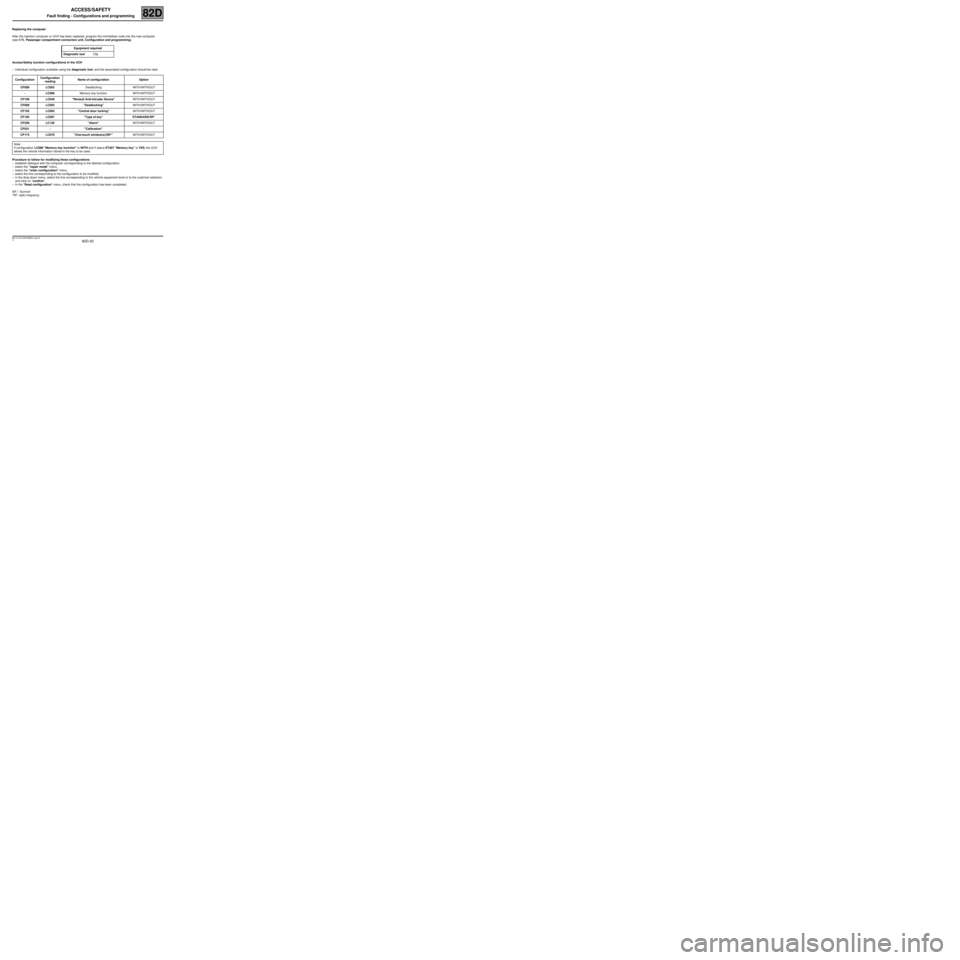
82D-20
MR-413-X44-82D000$600_eng.mif
V1
82D
ACCESS/SAFETY
Fault finding - Configurations and programming
Replacing the computer
After the injection computer or UCH has been replaced, program the immobiliser code into the new computer
(see 87B, Passenger compartment connection unit, Configuration and programming).
Access/Safety function configurations in the UCH
–Individual configuration available using the diagnostic tool, and the associated configuration should be read
Procedure to follow for modifying these configurations
–establish dialogue with the computer corresponding to the desired configuration.
–select the "repair mode" menu,
–select the "enter configuration" menu,
–select the line corresponding to the configuration to be modified,
–in the drop-down menu, select the line corresponding to the vehicle equipment level or to the customer selection
and click on "confirm",
–In the "Read configuration" menu, check that the configuration has been completed.
SR.*: Sunroof
*RF: radio frequencyEquipment required
Diagnostic toolClip
ConfigurationConfiguration
readingName of configuration Option
CF009 LC003Deadlocking WITH/WITHOUT
-LC089Memory key function WITH/WITHOUT
CF108 LC040 "Renault Anti-Intruder Device"WITH/WITHOUT
CF009 LC003 "Deadlocking"WITH/WITHOUT
CF192 LC093 "Central door locking"WITH/WITHOUT
CF195 LC097 "Type of key" STANDARD/RF*
CF229 LC126 "Alarm"WITH/WITHOUT
CF031 - "Calibration"-
CF173 LC070 "One-touch window(s)/SR*"WITH/WITHOUT
Note:
If configuration LC089 "Memory key function" is WITH and if status ET407 "Memory key" is YES, the UCH
allows the vehicle information stored in the key to be used.
MR-413-X44-82D000$600_eng.mif
Page 21 of 43
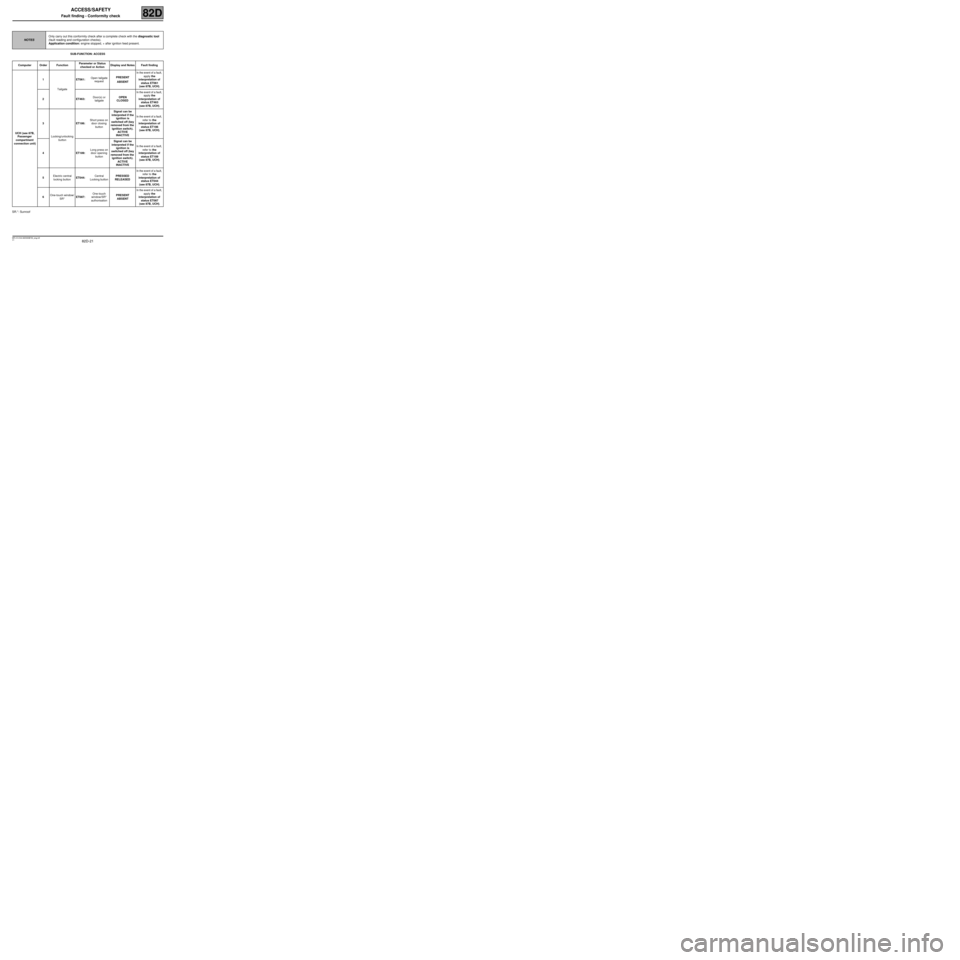
82D-21
MR-413-X44-82D000$700_eng.mif
V1
82D
ACCESS/SAFETY
Fault finding - Conformity check
SUB-FUNCTION: ACCESS
SR.*: Sunroof
NOTESOnly carry out this conformity check after a complete check with the diagnostic tool
(fault reading and configuration checks).
Application condition: engine stopped, + after ignition feed present.
Computer Order FunctionParameter or Status
checked or ActionDisplay and Notes Fault finding
UCH (see 87B,
Passenger
compartment
connection unit)1
TailgateET061:Open tailgate
requestPRESENT
ABSENTIn the event of a fault,
apply the
interpretation of
status ET061
(see 87B, UCH).
2ET463:Door(s) or
tailgateOPEN
CLOSEDIn the event of a fault,
apply the
interpretation of
status ET463
(see 87B, UCH).
3
Locking/unlocking
buttonET186:Short press on
door closing
buttonSignal can be
interpreted if the
ignition is
switched off (key
removed from the
ignition switch).
ACTIVE
INACTIVEIn the event of a fault,
refer to the
interpretation of
status ET186
(see 87B, UCH).
4ET189:Long press on
door opening
buttonSignal can be
interpreted if the
ignition is
switched off (key
removed from the
ignition switch).
ACTIVE
INACTIVEIn the event of a fault,
refer to the
interpretation of
status ET189
(see 87B, UCH).
5Electric central
locking buttonET044:Central
Locking buttonPRESSED
RELEASEDIn the event of a fault,
refer to the
interpretation of
status ET044
(see 87B, UCH).
6One-touch window/
SR*ET087:One-touch
window/SR*
authorisationPRESENT
ABSENTIn the event of a fault,
apply the
interpretation of
status ET087
(see 87B, UCH).
MR-413-X44-82D000$700_eng.mif
Page 22 of 43
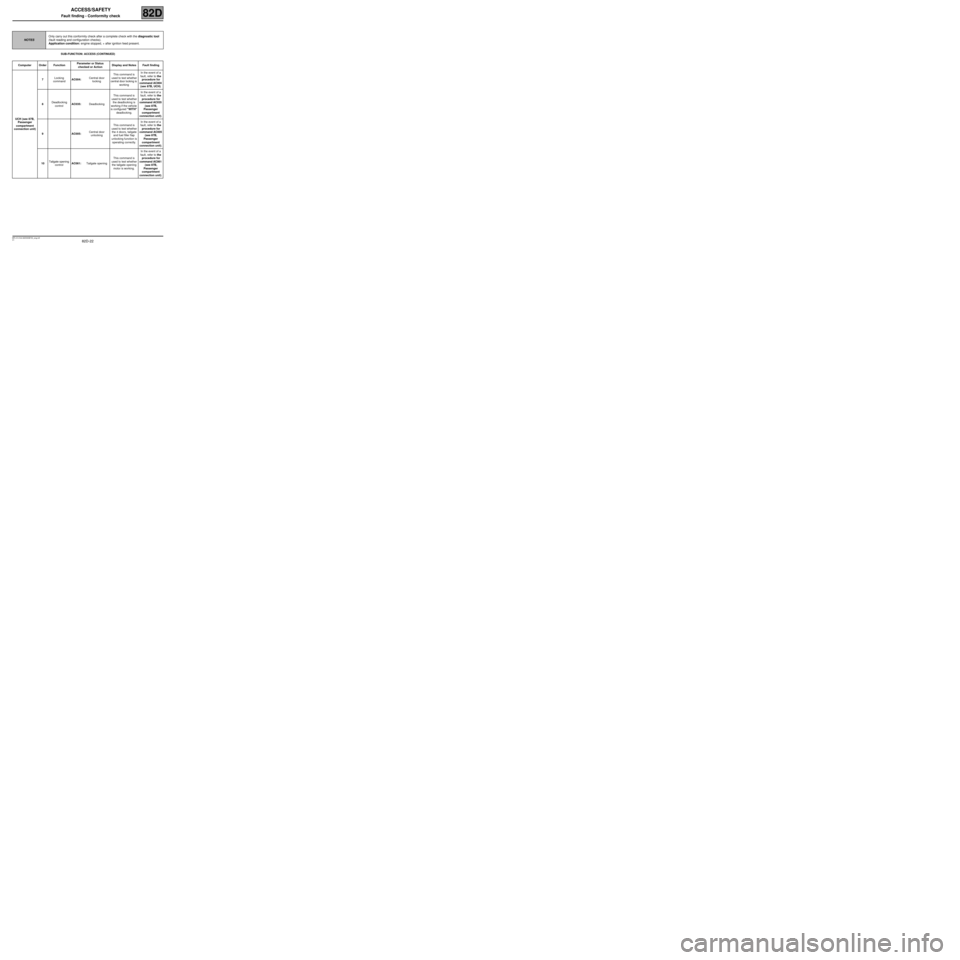
82D-22
MR-413-X44-82D000$700_eng.mif
V1
ACCESS/SAFETY
Fault finding - Conformity check82D
SUB-FUNCTION: ACCESS (CONTINUED)
NOTESOnly carry out this conformity check after a complete check with the diagnostic tool
(fault reading and configuration checks).
Application condition: engine stopped, + after ignition feed present.
Computer Order FunctionParameter or Status
checked or ActionDisplay and Notes Fault finding
UCH (see 87B,
Passenger
compartment
connection unit)7Locking
commandAC004:Central door
lockingThis command is
used to test whether
central door locking is
workingIn the event of a
fault, refer to the
procedure for
command AC004
(see 87B, UCH).
8Deadlocking
controlAC035:DeadlockingThis command is
used to test whether
the deadlocking is
working if the vehicle
is configured "WITH"
deadlocking.In the event of a
fault, refer to the
procedure for
command AC035
(see 87B,
Passenger
compartment
connection unit).
9AC005:Central door
unlockingThis command is
used to test whether
the 4 doors, tailgate
and fuel filler flap
unlocking function is
operating correctly.In the event of a
fault, refer to the
procedure for
command AC005
(see 87B,
Passenger
compartment
connection unit).
10Tailgate opening
controlAC061:Tailgate openingThis command is
used to test whether
the tailgate opening
motor is working.In the event of a
fault, refer to the
procedure for
command AC061
(see 87B,
Passenger
compartment
connection unit).
Page 31 of 43
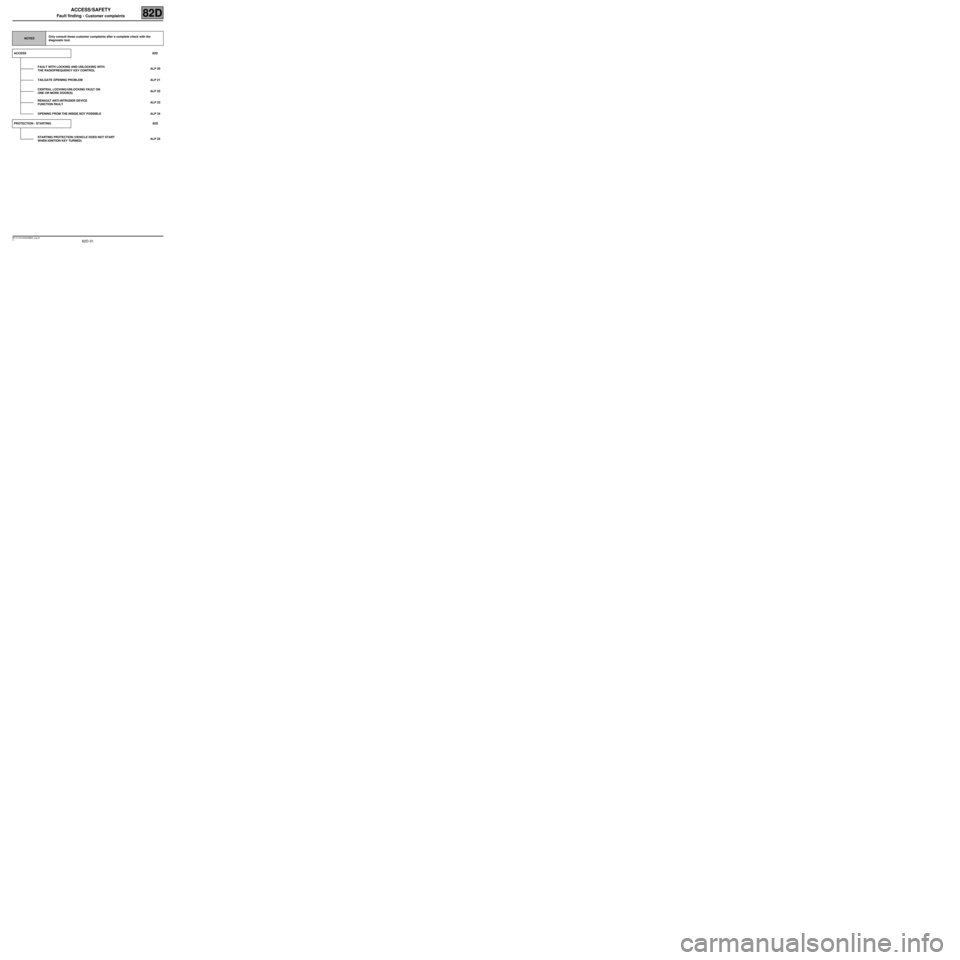
82D-31
MR-413-X44-82D000$800_eng.mif
V1
82D
ACCESS/SAFETY
Fault finding - Customer complaints
NOTESOnly consult these customer complaints after a complete check with the
diagnostic tool.
ACCESS82D
FAULT WITH LOCKING AND UNLOCKING WITH
THE RADIOFREQUENCY KEY CONTROLALP 20
TAILGATE OPENING PROBLEM ALP 21
CENTRAL LOCKING/UNLOCKING FAULT ON
ONE OR MORE DOOR(S)ALP 22
RENAULT ANTI-INTRUDER DEVICE
FUNCTION FAULTALP 23
OPENING FROM THE INSIDE NOT POSSIBLE ALP 24
PROTECTION - STARTING82D
STARTING PROTECTION (VEHICLE DOES NOT START
WHEN IGNITION KEY TURNED)ALP 25
MR-413-X44-82D000$800_eng.mif
Page 32 of 43
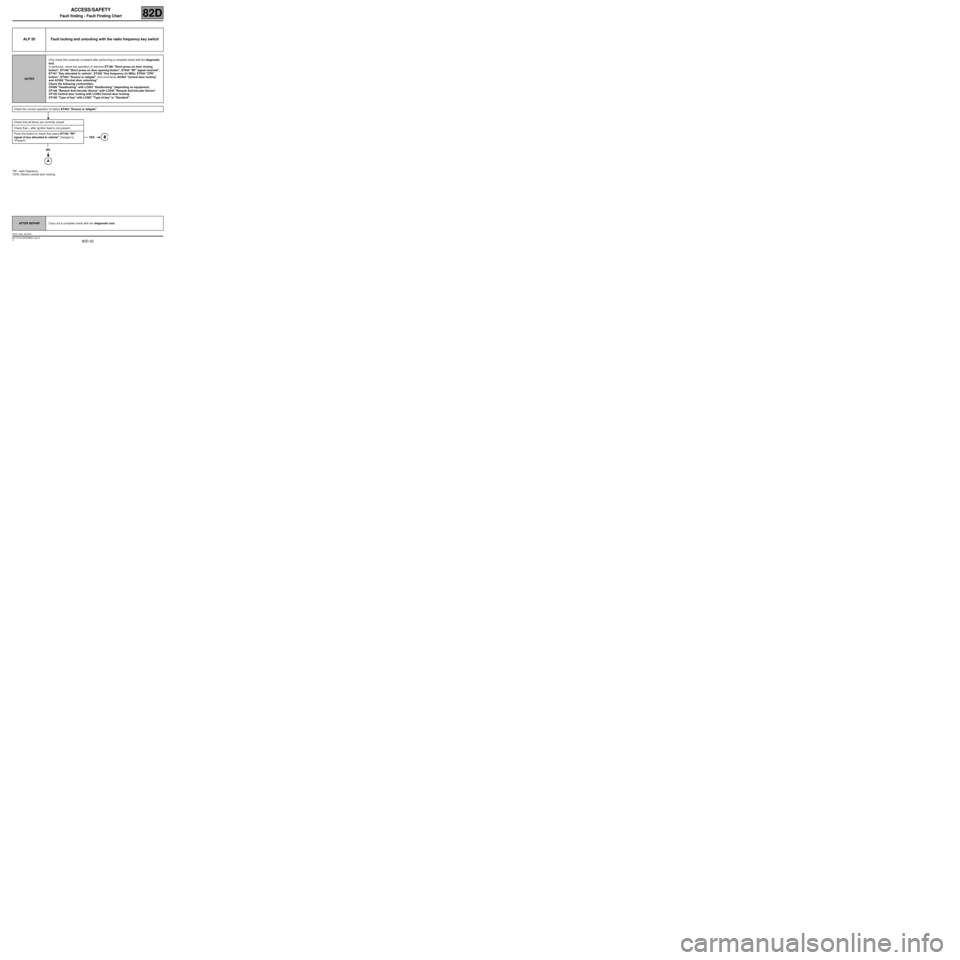
82D-32
MR-413-X44-82D000$900_eng.mif
V1
82D
ACCESS/SAFETY
Fault finding - Fault Finding Chart
*RF: radio frequency
*CPE: Electric central door locking
ALP 20 Fault locking and unlocking with the radio frequency key switch
NOTESOnly check this customer complaint after performing a complete check with the diagnostic
tool.
In particular, check the operation of statuses ET186 "Short press on door closing
button", ET189 "Short press on door opening button", ET045 "RF* signal received",
ET181 "Key allocated to vehicle", ET240 "Key frequency (in MHz), ET044 "CPE*
button", ET463 "Door(s) or tailgate" and commands AC004 "Central door locking"
and AC005 "Central door unlocking".
Check the following conformities:
CF009 "Deadlocking" with LC003 "Deadlocking" (depending on equipment).
CF108 "Renault Anti-Intruder Device" with LC040 "Renault Anti-Intruder Device".
CF192 Central door locking with LC093 Central door locking.
CF195 "Type of key" with LC097 "Type of key" is "Standard".
Check the correct operation of status ET463 "Door(s) or tailgate".
Check that all doors are correctly closed.
Check that + after ignition feed is not present.
Press the button to check that status ET193 "RF*
signal of key allocated to vehicle" changes to
"Present".
NO
YES
AFTER REPAIRCarry out a complete check with the diagnostic tool.
UCH_V44_ALP20
MR-413-X44-82D000$900_eng.mif
Page 33 of 43
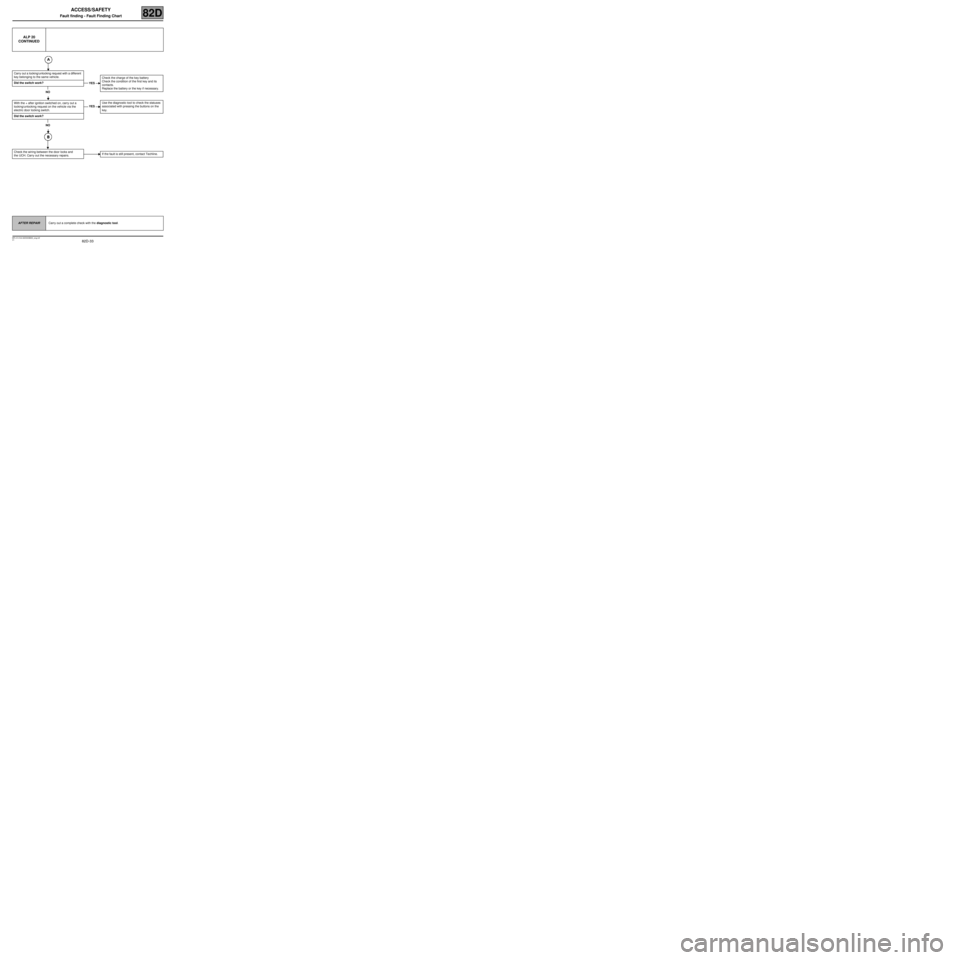
82D-33
MR-413-X44-82D000$900_eng.mif
V1
ACCESS/SAFETY
Fault finding - Fault Finding Chart82D
ALP 20
CONTINUED
Carry out a locking/unlocking request with a different
key belonging to the same vehicle.
Did the switch work?
NO
With the + after ignition switched on, carry out a
locking/unlocking request on the vehicle via the
electric door locking switch.
Did the switch work?
NO
Check the wiring between the door locks and
the UCH. Carry out the necessary repairs.
YESCheck the charge of the key battery
Check the condition of the first key and its
contacts.
Replace the battery or the key if necessary.
YESUse the diagnostic tool to check the statuses
associated with pressing the buttons on the
key.
If the fault is still present, contact Techline.
AFTER REPAIRCarry out a complete check with the diagnostic tool.